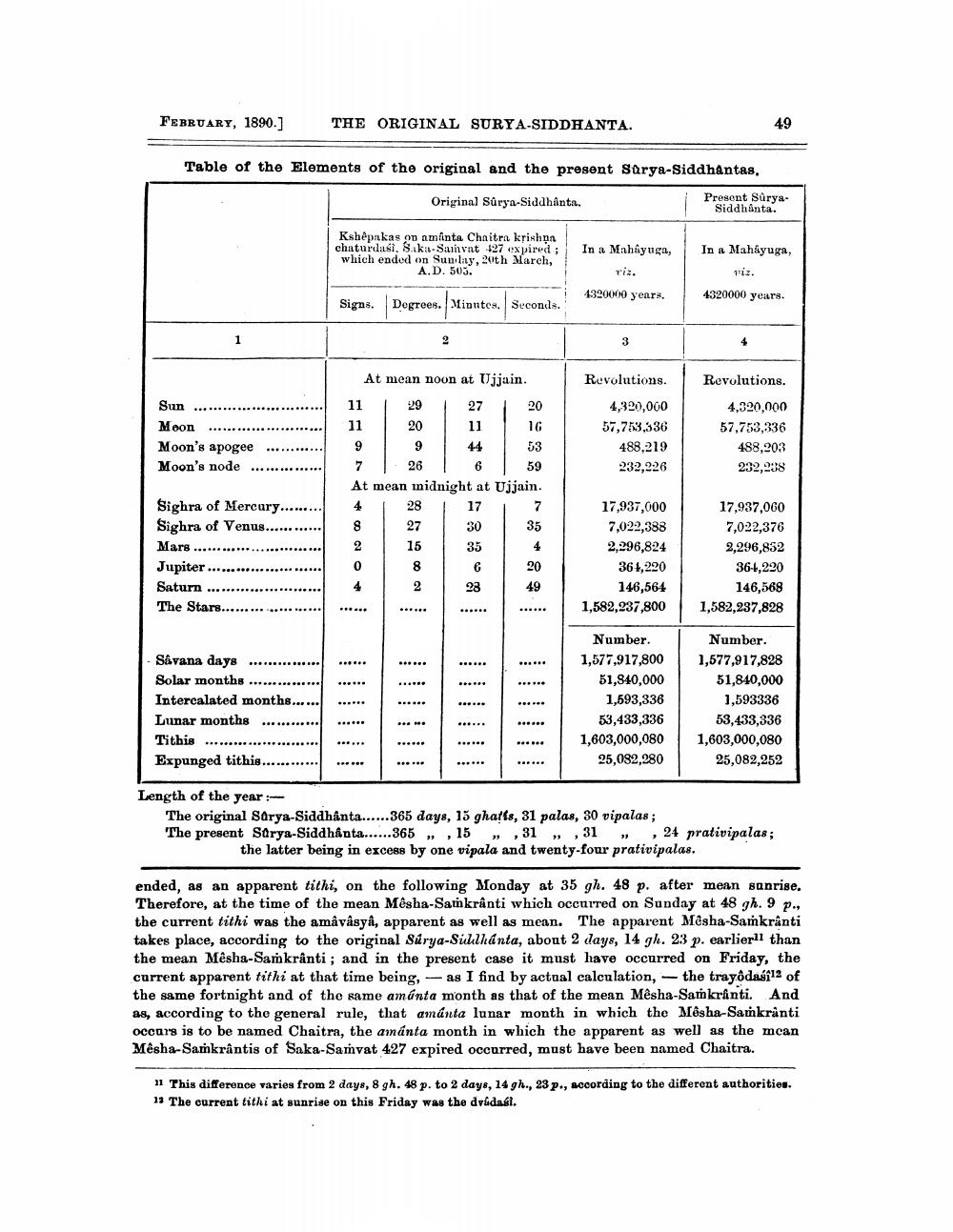________________
FEBRUARY, 1890.]
Table of the Elements of the original and the present Sürya-Siddhantas,
Original Surya-Siddhanta.
Kshêpakas on amânta Chaitra krishna chaturdasi, Saka-Samvat 427 expired; which ended on Sunday, 20th March, A.D. 505.
Degrees. Minutes. Seconds.
Sun Moon
Moon's apogee
Moon's node
Sighra of Mercury........
Sighra of Venus.......
Mars.......
Jupiter.
Saturn
The Stars.........
***********.
Savana days
Solar months
***********
Intercalated months.....
Lunar months
Tithis
*****************
Expunged tithis......
THE ORIGINAL SURYA-SIDDHANTA.
Signs.
11
11
At mean noon at Ujjain.
29
20
27
11
44
7
6
At mean midnight at Ujjain.
4
17
8
2
0
4
26
28
27
15
8
2
⠀⠀⠀⠀⠀⠀
2
......
******
30
35
တော်
28
20
16
53
59
⠀⠀⠀⠀⠀⠀
73429
35
20
In a Mahayuga,
viz.
4320000 years.
3
Revolutions.
4,320,000
57,753,336
488,219
232,226
17,937,000
7,022,388
2,296,824
361,220
146,564 1,582,237,800
Number. 1,577,917,800
51,840,000
1,593,336
53,433,336 1,603,000,080 25,082,280
49
Present SuryaSiddhanta.
-
In a Mahayuga, viz.
4320000 years.
Revolutions.
4,320,000
57,753,336
488,203
232,238
17,937,060
7,022,376
2,296,832
36-4,220
146,568
1,582,237,828
Number.
1,577,917,828
51,840,000
1,593336
53,433,336
1,603,000,080 25,082,252
Length of the year :
The original Surya-Siddhânta......365 days, 15 ghatis, 31 palas, 30 vipalas; The present Surya-Siddhanta......365,15,,,31,,, 31, 24 prativipalas; the latter being in excess by one vipala and twenty-four prativipalas.
ended, as an apparent tithi, on the following Monday at 35 gh. 48 p. after mean sunrise. Therefore, at the time of the mean Mêsha-Samkrânti which occurred on Sunday at 48 gh. 9 p., the current tithi was the amâvâsyâ, apparent as well as mean. The apparent Mêsha-Samkrânti takes place, according to the original Surya-Siddhanta, about 2 days, 14 gh. 23 p. earlier than the mean Mêsha-Samkrânti; and in the present case it must have occurred on Friday, the current apparent tithi at that time being, - - as I find by actual calculation, the trayôdasî12 of the same fortnight and of the same amúnta month as that of the mean Mêsha-Samkrânti. And as, according to the general rule, that amánta lunar month in which the Mêsha-Samkranti occurs is to be named Chaitra, the amánta month in which the apparent as well as the mean Mêsha-Samkrântis of Saka-Samvat 427 expired occurred, must have been named Chaitra.
11 This difference varies from 2 days, 8 gh. 48 p. to 2 days, 14 gh., 23 p., according to the different authorities. 13 The current tithi at sunrise on this Friday was the drudasi.




